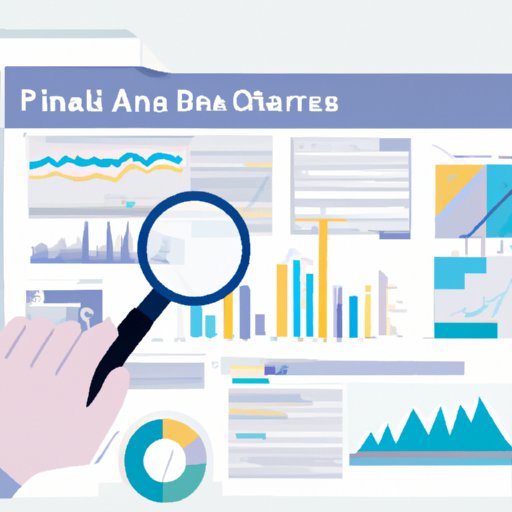Introduction
Horizontal analysis is an important tool for businesses that want to understand their performance and make better financial decisions. It is a method of analyzing financial statements over time to identify trends and compare different periods of performance. This article will explain what horizontal analysis is, why it is used, and provide a step-by-step guide for performing a horizontal analysis of financial statements.

Definition of Horizontal Analysis for Financial Statements
Horizontal analysis is a method of financial statement analysis that involves comparing line items in financial statements from different accounting periods. It is also known as trend analysis or trend study. It is used to identify changes in financial performance over time, to compare financial performance with other companies, and to assess risk levels. The analysis is conducted by calculating the percentage change between two or more years.

Purpose of Horizontal Analysis for Financial Statements
The purpose of horizontal analysis is to identify trends and patterns in financial data and to evaluate the overall performance of a business. By comparing financial information from different accounting periods, businesses can gain insight into their financial performance and make better decisions. It can also be used to compare financial performance with other companies in the same industry or sector.
Step-by-Step Guide to Performing a Horizontal Analysis of Financial Statements
Performing a horizontal analysis of financial statements requires the following steps:
Step 1: Gather Necessary Financial Data
The first step in performing a horizontal analysis of financial statements is to gather all relevant financial data. This includes income statements, balance sheets, and cash flow statements. This data should be collected for multiple accounting periods to allow for comparison.
Step 2: Calculate Ratios and Percentages
Once the necessary financial data has been collected, the next step is to calculate ratios and percentages. This involves calculating year-over-year growth rates, return on investment, profit margins, and other key metrics. These calculations will help to identify trends and patterns in the data.
Step 3: Create a Spreadsheet of Financial Data
The third step is to create a spreadsheet of the financial data. This spreadsheet should include all of the line items from the financial statements and the corresponding ratios and percentages. This will allow for easy comparison of the data.
Step 4: Analyze the Data
The fourth step is to analyze the data. This involves looking for trends and patterns in the financial data and evaluating the overall financial performance of the business. This analysis can be done manually or with specialized software.
A Comprehensive Overview of Horizontal Analysis for Financial Statements
Horizontal analysis is a powerful tool for understanding financial performance and making better decisions. It can be used to analyze a variety of financial metrics, including growth rates, trends in financial data, and comparisons between financial statements.
Calculating Growth Rates
One of the key benefits of horizontal analysis is that it allows businesses to calculate growth rates. This involves comparing the current period’s financial data with the previous period’s financial data. This can be done for revenue, expenses, net income, and other metrics. The calculation of a growth rate can help to identify areas of improvement and areas where performance is declining.
Examining Trends in Financial Data
Another benefit of horizontal analysis is that it allows businesses to examine trends in financial data. This involves looking at the data over multiple accounting periods to identify any patterns or trends in performance. This can help businesses to identify areas of strength and weakness and to plan for future performance.
Comparing Financial Statements
Horizontal analysis can also be used to compare financial statements. This involves comparing the financial data of one company with that of another company or the industry average. This can help businesses to identify areas of improvement and areas where they are outperforming their competitors.

Uncovering Trends in Financial Data Through Horizontal Analysis
Horizontal analysis can be used to uncover trends in financial data and to identify areas of strength and weakness. By comparing financial data from different accounting periods, businesses can gain insight into their performance and make better decisions.
Understanding the Significance of Horizontal Analysis
It is important to understand the significance of horizontal analysis when evaluating financial performance. This involves understanding how the data can be used to identify trends and patterns in performance and how this can be used to make better decisions.
Analyzing Financial Performance with Horizontal Analysis
Horizontal analysis can be used to analyze financial performance. This involves examining profitability ratios, liquidity ratios, asset management ratios, and other metrics. By analyzing these metrics, businesses can gain insight into their performance and identify areas of improvement.
Applying Horizontal Analysis to Financial Statements
Horizontal analysis can also be used to apply financial analysis to financial statements. This involves evaluating performance over time, assessing risk levels, and identifying areas of improvement. By applying horizontal analysis to financial statements, businesses can gain a better understanding of their financial performance and make better decisions.
Utilizing Horizontal Analysis to Compare Financial Statements
Horizontal analysis can also be used to compare financial statements. This involves comparing different financial periods, comparing performance against other companies, and comparing performance against industry averages. By comparing financial statements, businesses can gain insight into their performance and make better decisions.
Comparing Different Financial Periods
Horizontal analysis can be used to compare different financial periods. This involves comparing line items from different accounting periods to identify trends and patterns in performance. This can help businesses to identify areas of improvement and areas where performance is declining.
Comparing Performance Against Other Companies
Horizontal analysis can also be used to compare performance against other companies. This involves comparing the financial data of one company with that of another company or the industry average. By comparing financial performance, businesses can gain insight into their performance and identify areas where they are outperforming their competitors.
Comparing Performance Against Industry Averages
Finally, horizontal analysis can be used to compare performance against industry averages. This involves comparing the financial data of a company with that of the industry average. This can help businesses to identify areas of improvement and areas where they are performing above the industry average.
Understanding the Significance of Horizontal Analysis for Financial Statements
Horizontal analysis is an important tool for businesses that want to understand their performance and make better financial decisions. It can be used to improve decision making, identify strengths and weaknesses, and create financial forecasts.
Improving Decision Making
Horizontal analysis can be used to improve decision making. By analyzing financial data over time, businesses can identify trends and patterns in performance and make better decisions about their future. This can help businesses to make more informed decisions about investments, operations, and other areas of the business.
Identifying Strengths and Weaknesses
Horizontal analysis can also be used to identify strengths and weaknesses in a business. By comparing financial data over multiple periods, businesses can identify areas of improvement and areas where performance is declining. This can help businesses to focus their efforts on areas of strength and address areas of weakness.
Creating Financial Forecasts
Finally, horizontal analysis can be used to create financial forecasts. By analyzing financial data over time, businesses can identify trends and make better predictions about future performance. This can help businesses to prepare for future opportunities and challenges.

Analyzing Financial Performance with Horizontal Analysis
Horizontal analysis can be used to analyze financial performance. This involves examining profitability ratios, liquidity ratios, asset management ratios, and other metrics. By analyzing these metrics, businesses can gain insight into their performance and identify areas of improvement.
Examining Profitability Ratios
Profitability ratios are used to measure the profitability of a business. They include gross margin, operating margin, net margin, return on assets, and return on equity. By examining these ratios, businesses can identify areas where performance is strong and areas where there is room for improvement.
Analyzing Liquidity Ratios
Liquidity ratios measure the ability of a business to meet its short-term obligations. They include current ratio, quick ratio, working capital ratio, and debt-to-equity ratio. By analyzing these ratios, businesses can identify areas where liquidity is strong and areas where there is room for improvement.
Evaluating Asset Management Ratios
Asset management ratios measure the efficiency with which a business is managing its assets. They include inventory turnover, accounts receivable turnover, fixed asset turnover, and total asset turnover. By examining these ratios, businesses can identify areas where asset management is strong and areas where there is room for improvement.
Applying Horizontal Analysis to Financial Statements for Better Decision Making
By applying horizontal analysis to financial statements, businesses can gain a better understanding of their financial performance and make better decisions. This involves evaluating performance over time, assessing risk levels, and identifying areas of improvement. By using horizontal analysis, businesses can gain insight into their performance and make more informed decisions.
Evaluating Performance Over Time
Horizontal analysis can be used to evaluate performance over time. This involves comparing line items from different accounting periods to identify trends and patterns in performance. This can help businesses to identify areas of improvement and areas where performance is declining.
Assessing Risk Levels
Horizontal analysis can also be used to assess risk levels. This involves comparing the financial data of one company with that of another company or the industry average. By doing this, businesses can identify areas of high risk and areas where the risk is low.
Identifying Areas of Improvement
Finally, horizontal analysis can be used to identify areas of improvement. By analyzing financial data over multiple periods, businesses can identify areas where performance is strong and areas where there is room for improvement. This can help businesses to focus their efforts on areas of strength and address areas of weakness.
Conclusion
Horizontal analysis is an important tool for examining financial statements. It is a method of analyzing financial data over time to identify trends and compare different periods of performance. This article has explained what horizontal analysis is, why it is used, and provided a step-by-step guide for performing a horizontal analysis of financial statements. It has also outlined the benefits of horizontal analysis for financial decisions, such as improving decision making, identifying strengths and weaknesses, and creating financial forecasts.
(Note: Is this article not meeting your expectations? Do you have knowledge or insights to share? Unlock new opportunities and expand your reach by joining our authors team. Click Registration to join us and share your expertise with our readers.)
